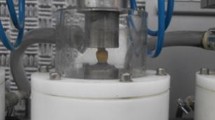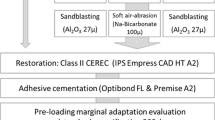Abstract
No information is available to date about cusp design of thin (1.0 mm) non-functional cusps and its influence upon (1) marginal integrity of ceramic inlays (CI) and partial ceramic crowns (PCC) and (2) crack formation of dental tissues. The aim of this in vitro study was to investigate the effect of cusp coverage of thin non-functional cusps on marginal integrity and enamel crack formation. CI and PCC preparations were performed on extracted human molars. Non-functional cusps were adjusted to 1.0-mm wall thickness and 1.0-mm wall thickness with horizontal reduction of about 2.0 mm. Ceramic restorations (Vita Mark II, Cerec3 System) were adhesively luted with Excite/Variolink II. The specimens were exposed to thermocycling and central mechanical loading. Marginal integrity was assessed by evaluating dye penetration after thermal cycling and mechanical loading. Enamel cracks were documented under a reflective-light microscope. The data were statistically analysed with the Mann–Whitney U test, the Fishers exact test (α = 0.05) and the error rates method. PCC with horizontal reduction of non-functional cusps showed statistically significant less microleakage than PCC without such a cusp coverage. Preparation designs with horizontal reduction of non-functional cusps showed a tendency to less enamel crack formation than preparation designs without cusp coverage. Thin non-functional cusp walls of adhesively bonded restorations should be completely covered or reduced to avoid enamel cracks and marginal deficiency.







Similar content being viewed by others

References
Abou-Rass M (1983) Crack lines: the precursors of tooth fractures—their diagnosis and treatment. Quintessence Int Dent Dig 14:437–447
Arola D, Huang MP (2000) The influence of simultaneous mechanical and thermal loads on the stress distribution in molars with amalgam restorations. J Mater Sci Mater Med 11:133–140
Bajaj D, Nazari A, Eidelman N, Arola DD (2008) A comparison of fatigue crack growth in human enamel and hydroxyapatite. Biomaterials 29:4847–4854
Bortolotto T, Onisor I, Krejci I (2007) Proximal direct composite restorations and chairside CAD/CAM inlays: marginal adaptation of a two-step self-etch adhesive with and without selective enamel conditioning. Clin Oral Investig 11:35–43
Bremer BD, Geurtsen W (2001) Molar fracture resistance after adhesive restoration with ceramic inlays or resin-based composites. Am J Dent 14:216–220
Burke FJ (1992) Tooth fracture in vivo and in vitro. J Dent 20:131–139
Burke FJ, Wilson NH, Watts DC (1994) Fracture resistance of teeth restored with indirect composite resins: the effect of alternative luting procedures. Quintessence Int 25:269–275
Clark DJ, Sheets CG, Paquette JM (2003) Definitive diagnosis of early enamel and dentin cracks based on microscopic evaluation. J Esthet Restor Dent 15:391–401
Denehy GE, Torney DL (1976) Internal enamel reinforcement through micromechanical bonding. J Prosthet Dent 36:171–175
Federlin M, Schmidt S, Hiller KA, Thonemann B, Schmalz G (2004) Partial ceramic crowns: influence of preparation design and luting material on internal adaptation. Oper Dent 29:560–570
Federlin M, Sipos C, Hiller KA, Thonemann B, Schmalz G (2005) Partial ceramic crowns. Influence of preparation design and luting material on margin integrity—a scanning electron microscopic study. Clin Oral Investig 9:8–17
Federlin M, Wagner J, Manner T, Hiller KA, Schmalz G (2007) Three-year clinical performance of cast gold vs ceramic partial crowns. Clin Oral Investig 11:345–352
Fonseca RB, Correr-Sobrinho L, Fernandes-Neto AJ, Quagliatto PS, Soares CJ (2008) The influence of the cavity preparation design on marginal accuracy of laboratory-processed resin composite restorations. Clin Oral Investig 12:53–59
Frankenberger R, Kramer N, Lohbauer U, Nikolaenko SA, Reich SM (2007) Marginal integrity: is the clinical performance of bonded restorations predictable in vitro? J Adhes Dent 9(Suppl 1):107–116
Geurtsen W, Schwarze T, Gunay H (2003) Diagnosis, therapy, and prevention of the cracked tooth syndrome. Quintessence Int 34:409–417
Habekost LV, Camacho GB, Pinto MB, Demarco FF (2006) Fracture resistance of premolars restored with partial ceramic restorations and submitted to two different loading stresses. Oper Dent 31:204–211
Hickel R, Manhart J (2001) Longevity of restorations in posterior teeth and reasons for failure. J Adhes Dent 3:45–64
Kidd EA (1976) Microleakage: a review. J Dent 4:199–206
Kramer N, Frankenberger R (2005) Clinical performance of bonded leucite-reinforced glass ceramic inlays and onlays after eight years. Dent Mater 21:262–271
Kramer N, Taschner M, Lohbauer U, Petschelt A, Frankenberger R (2008) Totally bonded ceramic inlays and onlays after eight years. J Adhes Dent 10:307–314
Krejci I, Reich T, Lutz F (2004) In-vitro-Testverfahren zur evaluation dentaler Restaurationssysteme. 3. Korrelation mit in-vivo-Resultaten. Schweiz Monatsschr Zahnmed 100:1445–1449
Lin CL, Chang YH, Chang WJ, Cheng MH (2006) Evaluation of a reinforced slot design for CEREC system to restore extensively compromised premolars. J Dent 34:221–229
Lloyd BA, McGinley MB, Brown WS (1978) Thermal stress in teeth. J Dent Res 57:571–582
Lohbauer U, Kramer N, Petschelt A, Frankenberger R (2008) Correlation of in vitro fatigue data and in vivo clinical performance of a glass ceramic material. Dent Mater 24:39–44
marante de Camargo DA, Sinhoreti MA, Correr-Sobrinho L, de SN, Consani S (2006) Influence of the methodology and evaluation criteria on determining microleakage in dentin-restorative interfaces. Clin Oral Investig 10:317–323
Mehl A, Godescha P, Kunzelmann KH, Hickel R (1996) Randspaltverhalten von Komposit-und Keramikinlays bei ausgedehnten Kavitäten. Dtsch Zahnarztl Z 51:701–704
Mondelli RF, Barbosa WF, Mondelli J, Franco EB, Carvalho RM (1998) Fracture strength of weakened human premolars restored with amalgam with and without cusp coverage. Am J Dent 11:181–184
Mota CS, Demarco FF, Camacho GB, Powers JM (2003) Microleakage in ceramic inlays luted with different resin cements. J Adhes Dent 5:63–70
Nothdurft FP, Schmitt T, Motter PJ, Pospiech PR (2008) Influence of fatigue testing and cementation mode on the load-bearing capability of bovine incisors restored with crowns and zirconium dioxide posts. Clin Oral Investig 12:331–336 doi:10.1007/s0078400802059
Preuss A, Rosentritt M, Frankenberger R, Beuer F, Naumann M (2008) Influence of type of luting cement used with all-ceramic crowns on load capability of post-restored endodontically treated maxillary central incisors. Clin Oral Investig 12:151–156
Pröbster L (2001) Sind vollkeramische Kronen und Brücken wissenschaftlich anerkannt? Gemeinsame Stellungnahme von DGZMK und DGZPW. Dtsch Zahnarztl Z 56:575–576
Ratcliff S, Becker IM, Quinn L (2001) Type and incidence of cracks in posterior teeth. J Prosthet Dent 86:168–172
Schenke F, Hiller KA, Schmalz G, Federlin M (2008) Marginal integrity of partial ceramic crowns within dentin with different luting techniques and materials. Oper Dent 33:516–525
Soares CJ, Martins LR, Pfeifer JM, Giannini M (2004) Fracture resistance of teeth restored with indirect-composite and ceramic inlay systems. Quintessence Int 35:281–286
St-Georges AJ, Sturdevant JR, Swift EJ Jr., Thompson JY (2003) Fracture resistance of prepared teeth restored with bonded inlay restorations. J Prosthet Dent 89:551–557
Stappert CF, Abe P, Kurths V, Gerds T, Strub JR (2008) Masticatory fatigue, fracture resistance, and marginal discrepancy of ceramic partial crowns with and without coverage of compromised cusps. J Adhes Dent 10:41–48
Stappert CF, Guess PC, Chitmongkolsuk S, Gerds T, Strub JR (2007) All-ceramic partial coverage restorations on natural molars. Masticatory fatigue loading and fracture resistance. Am J Dent 20:21–26
van Dijken JW, Hasselrot L, Ormin A, Olofsson AL (2001) Restorations with extensive dentin/enamel-bonded ceramic coverage. A 5-year follow-up. Eur J oral Sci 109:222–229
Wagner J, Hiller KA, Schmalz G (2003) Long-term clinical performance and longevity of gold alloy vs ceramic partial crowns. Clin Oral Investig 7:80–85
Walker BN, Makinson OF, Peters MC (1998) Enamel cracks. The role of enamel lamellae in caries initiation. Aust Dent J 43:110–116
Acknowledgment
The authors express their thanks and appreciation to Prof Dr Loys J Nunez, Memphis, TN, USA, for his constructive criticism and advice regarding the manuscript.
Conflict of interest
The authors declare that they have no conflict of interest.
Author information
Authors and Affiliations
Corresponding author
Rights and permissions
About this article
Cite this article
Krifka, S., Stangl, M., Wiesbauer, S. et al. Influence of different cusp coverage methods for the extension of ceramic inlays on marginal integrity and enamel crack formation in vitro. Clin Oral Invest 13, 333–341 (2009). https://doi.org/10.1007/s00784-008-0239-z
Received:
Accepted:
Published:
Issue Date:
DOI: https://doi.org/10.1007/s00784-008-0239-z



